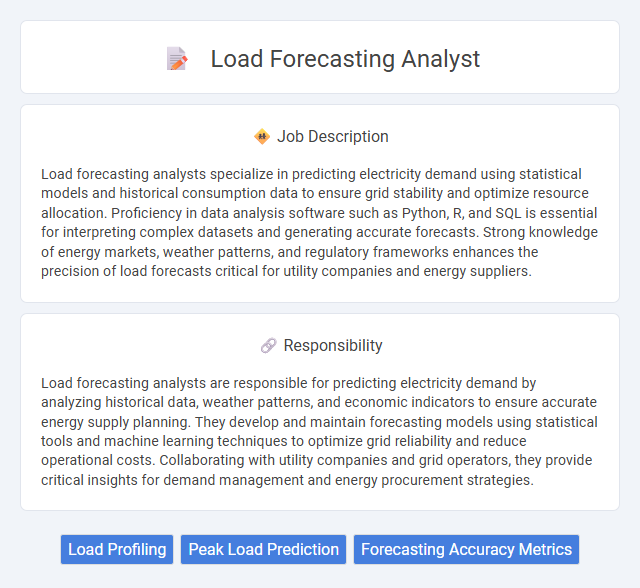
Load forecasting analysts specialize in predicting electricity demand using statistical models and historical consumption data to ensure grid stability and optimize resource allocation. Proficiency in data analysis software such as Python, R, and SQL is essential for interpreting complex datasets and generating accurate forecasts. Strong knowledge of energy markets, weather patterns, and regulatory frameworks enhances the precision of load forecasts critical for utility companies and energy suppliers.
Individuals with strong analytical skills and a keen interest in data patterns are likely to excel as Load Forecasting Analysts. Those comfortable working with complex statistical models and interpreting energy consumption trends may find the role highly suitable. People who thrive in detail-oriented environments and can adapt to fast-changing market conditions will probably perform well in this position.
Qualification
A Load Forecasting Analyst typically requires a strong background in electrical engineering, data science, or applied mathematics, along with proficiency in statistical modeling and time series analysis. Expertise in software tools such as Python, R, MATLAB, or specialized forecasting platforms is essential for developing accurate demand predictions. Strong analytical skills, knowledge of power systems, and experience with big data analytics enhance the ability to deliver reliable load forecasts critical for energy planning and grid management.
Responsibility
Load forecasting analysts are responsible for predicting electricity demand by analyzing historical data, weather patterns, and economic indicators to ensure accurate energy supply planning. They develop and maintain forecasting models using statistical tools and machine learning techniques to optimize grid reliability and reduce operational costs. Collaborating with utility companies and grid operators, they provide critical insights for demand management and energy procurement strategies.
Benefit
Load forecasting analysts can significantly improve energy management efficiency by predicting demand patterns accurately, which may lead to cost savings and optimized resource allocation. Their insights potentially help utility companies reduce the risk of outages and enhance grid reliability. Opportunities for career growth and skill development in data analytics and energy markets also appear likely.
Challenge
Load forecasting analysts likely face challenges in accurately predicting energy demand due to fluctuating weather patterns and variable consumer behavior. Integrating vast datasets from renewable energy sources and grid operations adds complexity that may impact forecast reliability. Evolving market regulations and technological advancements probably require continuous adaptation and skill development to maintain forecasting precision.
Career Advancement
Load forecasting analysts leverage advanced data modeling and statistical techniques to predict electricity demand, playing a critical role in energy management and planning. Mastery of machine learning algorithms and proficiency in tools like Python, SQL, and Power BI significantly enhance career progression opportunities in energy firms and consulting agencies. Pursuing certifications in data analytics and energy systems further accelerates advancement to senior analyst or energy consultant roles with strategic influence.
Key Terms
Load Profiling
Load forecasting analysts specializing in load profiling develop accurate models to predict electricity demand patterns based on historical consumption data, weather variables, and customer behavior. They analyze granular load profiles to identify peak usage periods, seasonal trends, and anomalies, enabling utilities to optimize grid operations and resource allocation. Proficiency in data analytics, predictive modeling, and energy market dynamics is essential for driving precise demand forecasts and enhancing load management strategies.
Peak Load Prediction
Load forecasting analysts specializing in peak load prediction use advanced statistical models and machine learning algorithms to accurately estimate the maximum electricity demand within a specific timeframe. They analyze historical consumption data, weather patterns, and socioeconomic factors to optimize grid reliability and prevent outages during high-demand periods. Their insights enable utility companies to plan capacity, manage resources efficiently, and reduce operational costs.
Forecasting Accuracy Metrics
Load forecasting analysts utilize forecasting accuracy metrics such as Mean Absolute Error (MAE), Root Mean Squared Error (RMSE), and Mean Absolute Percentage Error (MAPE) to evaluate and improve the precision of energy demand predictions. These metrics enable analysts to quantify the deviation between predicted and actual load values, guiding model adjustments and enhancing future forecast reliability. Effective use of accuracy metrics directly impacts operational efficiency, cost management, and grid stability in energy sector applications.
 kuljobs.com
kuljobs.com